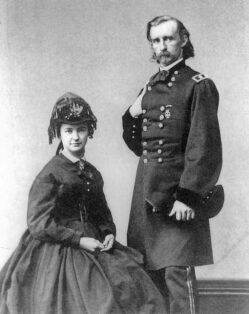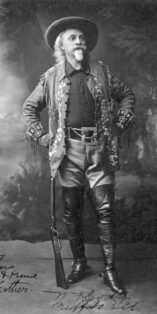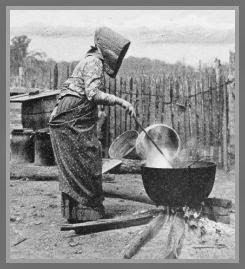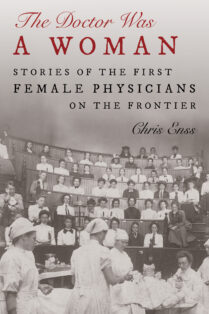1929 – Aviator Anne Morrow Lindbergh makes her first solo flight
Legendary Fashion Trendsetters – George and Elizabeth Custer
Enter now to win a copy of
How the West Was Worn: Bustles and Buckskins on the Wild Frontier

Clothing historians believe that no couple made more of an impact on western fashion than George and Elizabeth Custer. George, the “Boy General,” carried on his duties as commander of the Seventh Cavalry dressed in fringed buckskin breeches and a jacket, a navy-blue shirt with a wide falling collar and a red cravat. His men so admired the look that they adopted it for the entire regiment.
Custer’s sense of style extended to women’s clothing as well. Elizabeth accompanied her husband on field maneuvers dressed in hoop skirts that measured five yards around the bottom. At times, the prairie wind would blow the skirt up and expose her petticoat. So, George designed an outfit for his wife that included a military-style riding jacket, a pleated undershirt, and a less cumbersome skirt. Strips of lead were sewn into the dress hems to keep it weighted down in a strong breeze.

How the West Was Worn 2
I'm looking forward to hearing from you! Please fill out this form and I will get in touch with you if you are the winner.
Join my email news list to enter the giveaway.
"*" indicates required fields
To learn more about trendsetters like the Custers read
How the West Was Worn: Bustles and Buckskins on the Wild Frontier
This Day…
1920 – Ethelda Bleibtrey leads an American medal sweep of the Antwerp Olympic women’s 300m freestyle with a world record swim of 4:34.0
Mr. Pettigrew Best Actress Award
This Day…
1873 – First free kindergarten in the U.S. started by Susan Blow in Carondelet, a suburb of St. Louis, Missouri
Legendary Trendsetter – Buffalo Bill Cody
Enter now to win a copy of
How the West Was Worn: Bustles and Buckskins on the Wild Frontier

“Buffalo Bill is a magnificent specimen of a man, and has a native grace of movement that is quite captivating. And a look that is unique and fitting in his work.” The Chicago Review, 1872
William Frederick Cody was a frontiersman and noted marksman of the American West. Not only did he bring Wild West shows into prominence, he was a bit of a fashion plate, as well. His knee-length fringe shirts, ornamental leather coats, engraved and embroidered thigh-high boots, and broad-brimmed hat made him one of the most recognizable figures in the United States and Europe. His curly, shoulder-length hair, thin moustache, and small goatee accentuated the look. Costume historians credit Buffalo Bill with “bringing a bit of sophistication to the unruly plains.”

How the West Was Worn 2
I'm looking forward to hearing from you! Please fill out this form and I will get in touch with you if you are the winner.
Join my email news list to enter the giveaway.
"*" indicates required fields
How the West Was Worn 2
I'm looking forward to hearing from you! Please fill out this form and I will get in touch with you if you are the winner.
Join my email news list to enter the giveaway.
"*" indicates required fields
To learn more about legendary trendsetters like Buffalo Bill read
How the West Was Worn: Bustles and Buckskins on the Wild Frontier
Fashions That Shaped The West
Enter now to win a copy of
How the West Was Worn: Bustles and Buckskins on the Wild Frontier

Everyday wear for women throughout the early West generally consisted of cotton, wool, or linen dresses or skirts protected by an apron. Skirts of the 1850s were simply large pieces of fabric cut into rectangles. Some had inseam pockets, while some had openings in the seams with separate pockets underneath. Workaday skirts and dresses were usually absent of any trim around the hem. If a woman insisted on wearing a hoop with her skirt or dress, the length of the garment measured at least 4 feet wider than the hoop. Dressy skirts, including those worn for dancing, were 2 inches from the ground. Skirts for working could be as high as 6 inches.
Most clothing for miners and their families was homemade. Women sewed endlessly, making and mending garments for themselves and for all the members of their family. The clothing they made reflected the conditions of climate, weather, and income. Woven fabrics were available at general stores and many women purchased what they could afford. Otherwise, they spun or wove most of the material needed for the clothes. The fabric was then dyed using plant leaves, stems and blossoms of wood and meadow flowers, roots, bark, nut-hulls, tree galls, berries, and fruit pits and skins. Sewing patterns you could purchase were unheard of until the late 1880s; instead, clothes were cut from homemade patterns, and occasionally, old garments were disassembled and used as patterns.
Women married to prospectors lucky enough to hit the mother lode dressed in more ornate styles, but like those struggling to make ends meet, still took into account how to keep clothes clean. Caring for clothing, regardless of whether the item was homemade or store-bought, required work and time. In 1867, a two-piece dress of white cotton with a printed background became popular due to its easy care and was sold in stores, then duplicated by seamstresses throughout the West. The garment was known as the “wash dress” because it could be laundered easily. Women from all socioeconomic backgrounds wore “wash dresses.”

How the West Was Worn 2
I'm looking forward to hearing from you! Please fill out this form and I will get in touch with you if you are the winner.
Join my email news list to enter the giveaway.
"*" indicates required fields
How the West Was Worn 2
I'm looking forward to hearing from you! Please fill out this form and I will get in touch with you if you are the winner.
Join my email news list to enter the giveaway.
"*" indicates required fields
To learn more about the sometimes bizarre, often beautiful, and highly inventive clothing of the Old West read How the West Was Worn: Bustles and Buckskins on the Wild Frontier.
This Day…
1889 – 1st ship-to-shore wireless message (“Sherman is sighted”) received in the US from Lightship No. 70 to a coastal receiving station at Cliff House in San Francisco
Big Sky Journal Review of The Doctor Was A Woman

“Historian Chris Enss brings to light the fascinating tales of 13 people who dedicated their lives to breaking barriers and saving lives in The Doctor Was a Woman: Stories of the First Female Physicians on the Frontier (TwoDot Books, $26.95). Fighting a patriarchal medical system, as well as overcoming the sexist distrust of their patients, the pioneering physicians featured — from Dr. Lillian Heath, who assisted in the first plastic surgery operation, to Dr. Sofie Herzog, who had a necklace made of the over 20 bullet slugs she removed from “outlaws and lawmen alike” — make an inspiring statement for gender equality, while also offering a glimpse into the medical practices of the late 19th and early 20th centuries.”
Big Sky Journal
This Day…
1848 – New York Herald is the first major eastern newspaper to report the discovery of gold in California


